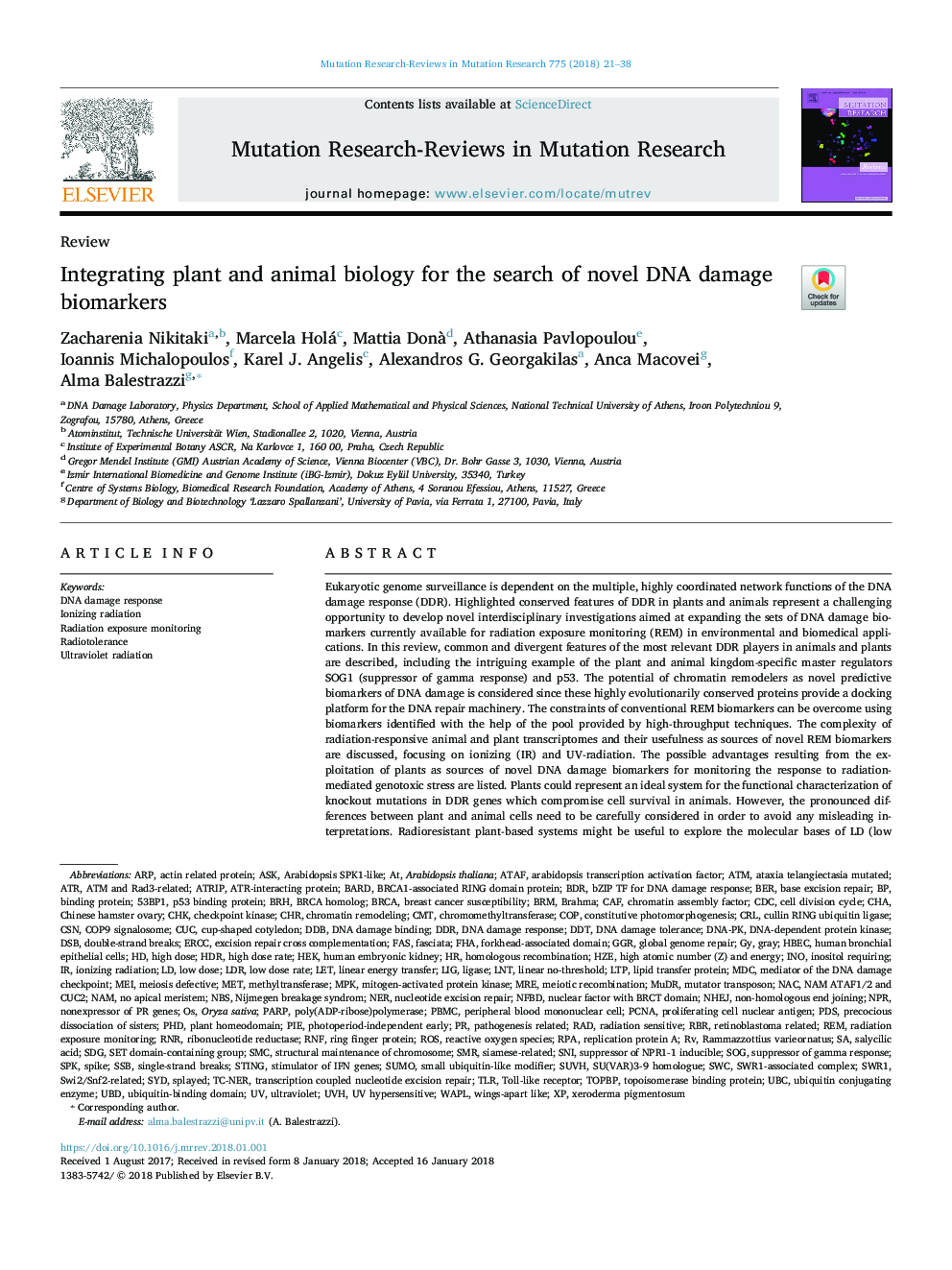| Article ID | Journal | Published Year | Pages | File Type |
|---|---|---|---|---|
| 8456695 | Mutation Research/Reviews in Mutation Research | 2018 | 18 Pages |
Abstract
Eukaryotic genome surveillance is dependent on the multiple, highly coordinated network functions of the DNA damage response (DDR). Highlighted conserved features of DDR in plants and animals represent a challenging opportunity to develop novel interdisciplinary investigations aimed at expanding the sets of DNA damage biomarkers currently available for radiation exposure monitoring (REM) in environmental and biomedical applications. In this review, common and divergent features of the most relevant DDR players in animals and plants are described, including the intriguing example of the plant and animal kingdom-specific master regulators SOG1 (suppressor of gamma response) and p53. The potential of chromatin remodelers as novel predictive biomarkers of DNA damage is considered since these highly evolutionarily conserved proteins provide a docking platform for the DNA repair machinery. The constraints of conventional REM biomarkers can be overcome using biomarkers identified with the help of the pool provided by high-throughput techniques. The complexity of radiation-responsive animal and plant transcriptomes and their usefulness as sources of novel REM biomarkers are discussed, focusing on ionizing (IR) and UV-radiation. The possible advantages resulting from the exploitation of plants as sources of novel DNA damage biomarkers for monitoring the response to radiation-mediated genotoxic stress are listed. Plants could represent an ideal system for the functional characterization of knockout mutations in DDR genes which compromise cell survival in animals. However, the pronounced differences between plant and animal cells need to be carefully considered in order to avoid any misleading interpretations. Radioresistant plant-based systems might be useful to explore the molecular bases of LD (low dose)/LDR (low dose rate) responses since nowadays it is extremely difficult to perform an accurate assessment of LD/LDR risk to human health. To overcome these constraints, researchers have started exploring radiotolerant non-human species as potential sources of information on the mechanisms involved in LD/LDR and general radiation responses.
Keywords
CAFDSBPBMCCOPSMCSPKLNTATRDDRHDRCDCSUMOFASHEKNACNHEJARPOryza sativaSWCPDSBRMSDGSYDBERSMRMDCREMTLRSNIPARPNBSCMTChrNPRiNOSOGRADPHDBRCACRLRPALDRMRERNRSSBFHABDRHBECDNA-PKATM and Rad3-related53BP1DDBMPKCUCCSNTC-NERRADiation sensitiveRBRERCCUBCUbDSWR1radiotolerancePCNAWAPLHZEATR-interacting proteinBRHRnflinear no-thresholdCUP-SHAPED COTYLEDONSPLAYEDstimulator of IFN genesconstitutive photomorphogenesisactin related proteinstructural maintenance of chromosomeataxia telangiectasia mutatedNERLIGMEIxeroderma pigmentosumROSubiquitin conjugating enzymeArabidopsis thalianaProliferating Cell Nuclear AntigenLETSpikeUltravioletUltraviolet radiationLinear Energy TransferGGRBARDcheckpoint kinaseMeiotic recombinationChromatin remodelingBrahmaionizing radiationDNA damage toleranceChinese Hamster Ovarynucleotide excision repairbase excision repairGlobal genome repairLTPreplication protein AToll-like receptorBreast cancer susceptibilityUbiquitin-binding domainGrayATMforkhead-associated domainHigh doselow doseDDTRibonucleotide reductaseATRIPPeripheral blood mononuclear cellHuman bronchial epithelial cellsCOP9 signalosomesingle-strand breaksdouble-strand breakschromatin assembly factornon-homologous end joiningLigaseMethyltransferaseMETHigh dose rateLow dose rateNAMCHAHomologous recombinationSTINGDNA-dependent protein kinaseDNA damage responsepathogenesis relatedPieASKlipid transfer proteinRING finger proteinbinding proteinmitogen-activated protein kinasepoly(ADP-ribose)polymeraseChkCell division cyclehuman embryonic kidneysmall ubiquitin-like modifierReactive oxygen speciesplant homeodomain
Related Topics
Life Sciences
Biochemistry, Genetics and Molecular Biology
Cancer Research
Authors
Zacharenia Nikitaki, Marcela Holá, Mattia Donà , Athanasia Pavlopoulou, Ioannis Michalopoulos, Karel J. Angelis, Alexandros G. Georgakilas, Anca Macovei, Alma Balestrazzi,
